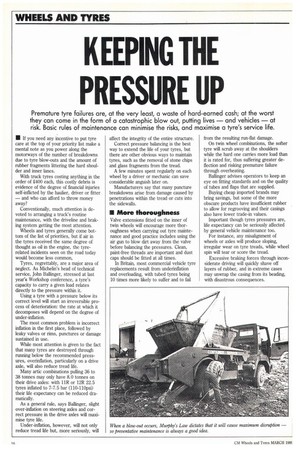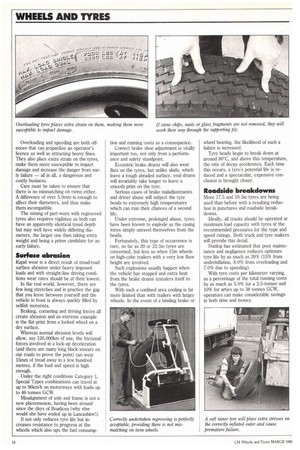KEEPING THE PRESSURE UP
Page 128

Page 130

If you've noticed an error in this article please click here to report it so we can fix it.
Premature lyre failures are, at the very least, a waste of hard-earned cash; at the worst they can come in the form of a catastrophic blow out, putting lives — and vehicles — at risk. Basic rules of maintenance can minimise the risks, and maximise a tyre's service life.
• If you need any incentive to put tyre care at the top of your priority list make a mental note as you power along the motorways of the number of breakdowns due to tyre blow-outs and the amount of rubber fragments littering the hard shoulder and inner lanes.
With truck tyres costing anything in the order of 2400 each, this costly debris is evidence of the degree of financial injuries self-inflicted by the haulier, driver or fitter — and who can afford to throw money away?
Conventionally, much attention is devoted to arranging a truck's routine maintenance, with the driveline and braking system getting the most attention.
Wheels and tyres generally come bottom of the list of priorities, but if air in the tyres received the same degree of thought as oil in the engine, the tyrerelated incidents seen on the road today would become less common, Tyres, regrettably, are a major area of neglect. As Michelin's head of technical service, John Ballinger, stressed at last year's Workshop conference, a tyre's capacity to carry a given load relates directly to the pressure within it.
Using a tyre with a pressure below its correct level will start an irreversible process of deterioration: the rate at which it decomposes will depend on the degree of under-inflation.
The most common problem is incorrect inflation in the first place, followed by leaky valves or rims, punctures or damage sustained in use.
While most attention is given to the fact that many tyres are destroyed through running below the recommended pressures, overinflation, particularly on a drive axle, will also reduce tread life.
Many artic combinations pulling 36 to 38 tonnes may only have 8.0 tonnes on their drive axles: with 11R or 12R 22.5 tyres inflated to 7-7.5 bar (110-11)psi) their life expectancy can be reduced dramatically.
As a general rule, says Ballinger, slight over-inflation on steering axles and correct pressure in the drive axles will maximise tyre life.
Under-inflation, however, will not only reduce tread life but, more seriously, will affect the integrity of the entire structure.
Correct pressure balancing is the best way to extend the life of your tyres, but there are other obvious ways to maintain tyres, such as the removal of stone chips and glass fragments from the tread.
A few minutes spent regularly on each wheel by a driver or mechanic can save considerable anguish later on.
Manufacturers say that many puncture breakdowns arise from damage caused by penetrations within the tread or cuts into the sidewalls.
• More thoroughness
Valve extensions fitted on the inner of twin wheels will encourage more thoroughness when carrying out tyre maintenance and good practice includes using the air gun to blow dirt away from the valve before balancing the pressures. Clean, paint-free threads are important and dust caps should be fitted at all times.
In Britain, most commercial vehicle tyre replacements result from underintlation and overloading, with tubed tyres being 10 times more likely to suffer and to fail from the resulting run-flat damage.
On twin wheel combinations, the softer tyre will scrub away at the shoulders while the hard one carries more load than it is rated for, thus suffering greater deflection and risking premature failure through overheating.
Ballinger advises operators to keep an eye on fitting standards and on the quality of tubes and flaps that are supplied.
Buying cheap imported brands may bring savings, but some of the more obscure products have insufficient rubber to allow for regrooving and their casings also have lower trade-in values.
Important though tyres pressures are, life expectancy can be seriously affected by general vehicle maintenance too.
For instance, any misalignment of wheels or axles will produce sloping, irregular wear on tyre treads, while wheel spin will tear or score the tread.
Excessive braking forces through inconsiderate driving will quickly shave off layers of rubber, and in extreme cases may unwrap the casing from its beading, with disastrous consequences. Overloading and speeding are both offences that can jeopardise an operator's licence as well as attracting heavy fines. They also place extra strain on the tyres, make them more susceptible to impact damage and increase the danger from early failure — all in all, a dangerous and costly business.
Care must be taken to ensure that there is no mismatching on twins either. A difference of over 5.0mm is enough to affect their diameters, and thus make them incompatible.
The mixing of part-worn with regrooved tyres also requires vigilance as both can have an apparently identical tread depth but may well have widely differing diameters, the larger one then taking extra weight and being a prime candidate for an early failure.
Surface abrasion
Rapid wear is a direct result of tread/road surface abrasion under heavy imposed loads and with straight-line driving conditions wear rates should be at their lowest.
In the real world, however, there are few long stretches and in practice the gap that you leave between yourself and the vehicle in front is always quickly filled by selfish motorists.
Braking, cornering and driving forces all create abrasion and an extreme example is the flat print from a locked wheel on a dry surface.
Whereas normal abrasion levels will allow, say 120,0001cm of use, the frictional forces involved in a lack-up deceleration (and there are many long black smears on our roads to prove the point) can wear 15rrun of tread away in a few hundred metres, if the load and speed is high enough.
Under the right conditions Category 1, Special Types combinations can travel at up to 96km/h on motorways with loads up to 46 tonnes GCW.
Misalignment of axle and frame is not a new phenomenon, having been around since the days of Boadicea (why else would she have ended up in Lancashire?).
It not only reduces tyre life but increases resistance to progress at the wheels which also ups the fuel consump tion and running costs as a consequence.
Correct brake shoe adjustment is vitally important too, not only from a performance and safety standpoint.
Eccentric brake drums will also wear flats on the tyres, but unlike skids, which leave a rough abraded surface, oval drums will invariably take longer to leave a smooth print on the tyre.
Serious cases of brake maladjustments and driver abuse will subject the tyre beads to extremely high temperatures which can ruin their chances of a second Life.
Under extreme, prolonged abuse, tyres have been known to explode as the casing wires simply unravel themselves from the beads.
Fortunately, this type of occurrence is rare, so far as 20 or 22.5in tyres are concerned, but less so when 15in wheels on high-cube trailers with a very low floor height are involved.
Such explosions usually happen when the vehicle has stopped and extra heat from the brake drums transfers itself to the tyres.
With such a confined area cooling is far more limited than with trailers with larger wheels. In the event of a binding brake or wheel bearing, the likelihood of such a failure is increased.
Tyre beads begin to break down at around 80°C, and above this temperature, the rate of decay accelerates. Each time this occurs, a tyre's potential life is reduced and a spectacular, expensive conclusion is brought closer.
Roadside breakdowns
More 17.5 and 19. Sin tyres are being used than before with a resulting reduction in punctures and roadside breakdowns.
Ideally, all trucks should be operated at maximum load capacity with tyres at the recommended pressures for the type and speed ratings. Both truck and tyre makers will provide this detail.
Dunlop has estimated that poor maintenance and negligence reduces optimum tyre life by as much as 30% (15% from underinilation, 8.0% from overloading and 7.0% due to speeding).
With tyre costs per kilometre varying, as a percentage of the total running costs by as much as 5.0% for a 3.5-tonner and 10% for artics up to 38 tonnes GCW, operators can make considerable savings in both time and money.








































































































































